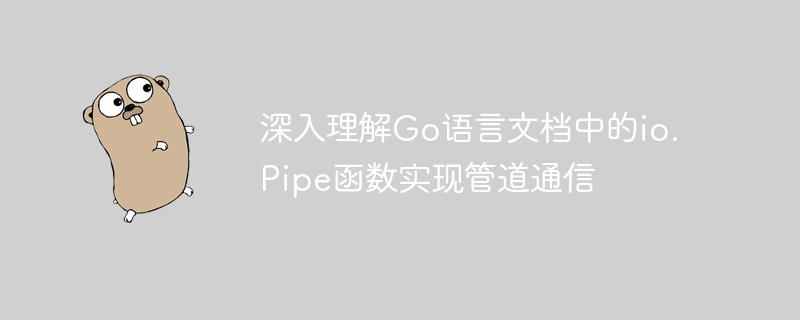

In-depth understanding of the io.Pipe function in the Go language document to implement pipeline communication requires specific code examples
Introduction:
In the Go language, through io. The Pipe function can conveniently implement pipeline communication. This article will delve into the use of the io.Pipe function and demonstrate its functions and usage scenarios through specific code examples.
1. Introduction to the io.Pipe function:
The io.Pipe function is a function provided by the io package of the Go language standard library, which is used to create an in-process pipeline. The pipeline created by the Pipe function can be used to communicate between different coroutines in the same process, thereby realizing data transmission and sharing.
2. Usage of io.Pipe function:
The basic usage of using io.Pipe function to create a pipeline is as follows:
func Pipe() (*PipeReader, *PipeWriter)
The return value of this function is two pointer types, namely PipeReader and PipeWriter. PipeReader is used to read data, and PipeWriter is used to write data.
Create a basic pipeline example:
package main
import (
"io"
"fmt"
)
func main() {
// 创建管道
reader, writer := io.Pipe()
// 在协程中写入数据
go func() {
defer writer.Close()
writer.Write([]byte("Hello, Pipe!"))
}()
// 从管道中读取数据
buf := make([]byte, 128)
n, err := reader.Read(buf)
if err != nil {
fmt.Println("Read error:", err)
return
}
fmt.Printf("Read %d bytes: %s
", n, buf[:n])
}In this example, we create a pipe and start a coroutine to write data, and then read from the pipe through the main coroutine data and print it out. The output is: "Read 13 bytes: Hello, Pipe!".
3. Application of io.Pipe function:
io.Pipe function is widely used. It can be used for data transmission between different coroutines, and can also be used to implement a simple message queue.
The following is an example of using pipes to transmit data:
package main
import (
"io"
"fmt"
"time"
)
func main() {
// 创建管道
reader, writer := io.Pipe()
// 开启一个协程写入数据
go func() {
defer writer.Close()
for i := 0; i < 5; i++ {
writer.Write([]byte(fmt.Sprintf("Message %d", i)))
time.Sleep(time.Second)
}
}()
// 主协程读取数据
go func() {
buf := make([]byte, 128)
for {
n, err := reader.Read(buf)
if err != nil {
fmt.Println("Read error:", err)
break
}
fmt.Printf("Read %d bytes: %s
", n, buf[:n])
}
}()
// 等待一段时间,观察输出结果
time.Sleep(time.Second * 10)
}In this example, we open two coroutines. One coroutine is used to write data, writing one message per second; the other coroutine is used to read data and print it out. After waiting for 10 seconds, we can observe the output as follows:
Read 9 bytes: Message 0 Read 9 bytes: Message 1 Read 9 bytes: Message 2 Read 9 bytes: Message 3 Read 9 bytes: Message 4
IV. Summary:
Through the io.Pipe function, we can easily implement data transmission between different coroutines in the same process and share. This article introduces the usage and application scenarios of the io.Pipe function through specific code examples. Using this function, we can easily implement intra-process pipeline communication and conveniently handle data transmission and communication between coroutines. It is also very helpful for a deep understanding of concurrent programming in Go language.
The above is the detailed content of In-depth understanding of the io.Pipe function in the Go language documentation to implement pipeline communication. For more information, please follow other related articles on the PHP Chinese website!
 Usage of Type keyword in Go
Usage of Type keyword in Go
 How to implement linked list in go
How to implement linked list in go
 What are the Go language programming software?
What are the Go language programming software?
 How to learn go language from 0 basics
How to learn go language from 0 basics
 What are the methods to implement operator overloading in Go language?
What are the methods to implement operator overloading in Go language?
 What are the operators in Go language?
What are the operators in Go language?
 Domestic free ChatGPT encyclopedia
Domestic free ChatGPT encyclopedia
 U coin price today
U coin price today




